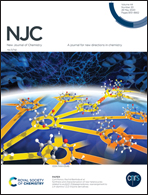Interfacing green synthesized flake like-ZnO with TiO2 for bilayer electron extraction in perovskite solar cells
Abstract
To improve the performance of PSCs, it is essential to prevent the carrier recombination losses at the interfaces of the transparent metal oxide electrode/electron transport layer (ETL)/active absorber perovskite layer. This present work reports on the green synthesis approach used for the preparation of flake like-ZnO nanostructure (GF-ZnO NS), naturally extracted from the leaf of Albizia Amara, used as a reducing cum capping agent. Herein, we have introduced an n-type GF-ZnO NS material as an efficient electron transport interfacial layer (bi-ETL) at the ETL/perovskite junction in the fabricated perovskite solar cells (PSCs). The structure of the fabricated PSC device is as follows: glass/ITO/bi-ETL (c-TiO2/GF-ZnO NSs)/CH3NH3PbI3−xClx/spiro-MeOTAD/Au. A comparative study has also been carried out by deploying electron transport materials such as c-TiO2 and GF-ZnO NSs separately. From this, it has been found that the bi-ETL perovskite solar cell devices achieved a maximum power conversion efficiency (PCE) of 7.83% with an open-circuit voltage (VOC) of 0.728 V, a short circuit current density (JSC) of 20.46 mA cm−2 and a fill factor (FF) of 52.61% whereas, the c-TiO2, GF-ZnO NSs and the chemically reduced CR-ZnO ETL based devices achieved a PCE of 4.84%, 5.82% and 6.81%, respectively. The better performance obtained for the bi-ETL based devices is ascribed to the enhanced carrier extraction and the reduced recombination losses at the interface between the ETL and the active perovskite layer.



 Please wait while we load your content...
Please wait while we load your content...